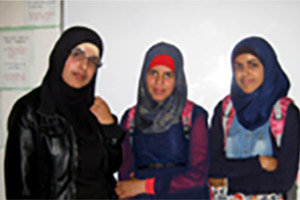Bedouin Grade 13 Program – A year to prepare for work and for life
An innovative Israel Sci-Tech model empowers Bedouins and integrates them into Israeli society and the workforce.
‘Camel-herder seeking a desk job?’
In 2006, the late Shimon Peres approached Zvi Peleg, Director-General of Israel Sci-Tech with this message: “Listen, young man, go to the Negev for two days, learn about the Bedouins and come and tell me what you learnt.” Mr. Peleg’s insights led to Mr. Peres asking us to open nine Bedouin schools in the region in a few short years.
Israel’s Bedouins
Most of Israel’s 210,000 Bedouins live in the Negev desert, 66% live below the breadline.
- 54% are under 14 years old
- Fifty to 80% of students dropped out by grade 8 (until now)
Employability is the key to change. If we can help young Bedouins find jobs or enter university to become engineers and teachers, then we can transform despair into hope, lives of crime, drugs and radicalism to productive lifestyles.
What is the 13th Year Model?
Building on our experience both in the Bedouin sector and in post-high school studies, in March 2015, our Thirteenth Grade program was established for Bedouin students.
Would-be engineers and practical engineers have an opportunity to complete matriculation and can obtain scholarships for further studies.
Vocational training will gear students for job training in specific fields, training them to qualify as pharmacy assistants, medical assistants, mechanics, electricians, welders and practical nurses, and attempts to link them with employment options. Students attend training courses in the field and take on apprenticeships in companies.
A special focus on girls has led to them staying in school longer than they did in the past. In fact, Bedouin girls study physics at a much higher rate than the boys, and even their Jewish peers. Because they are traditionally discouraged from leaving the home, women in all three tracks will be part of personal empowerment workshops.
Since Israel Sci-Tech opened our Bedouin schools, there have been big far-reaching changes:
- The greatest success: the dropout rate amongst boys and girls is almost zero.
- Girls make up 60% of the schools, sitting in class with their aymemmas (traditional filmy shawls) half-concealing their faces, smiles shining through.
- In one school, there are only girls in the highest chemistry class; in the biology class there are 25 girls and only 5 boys.
- Violence has plummeted, as boys have structure and hope for their futures.






